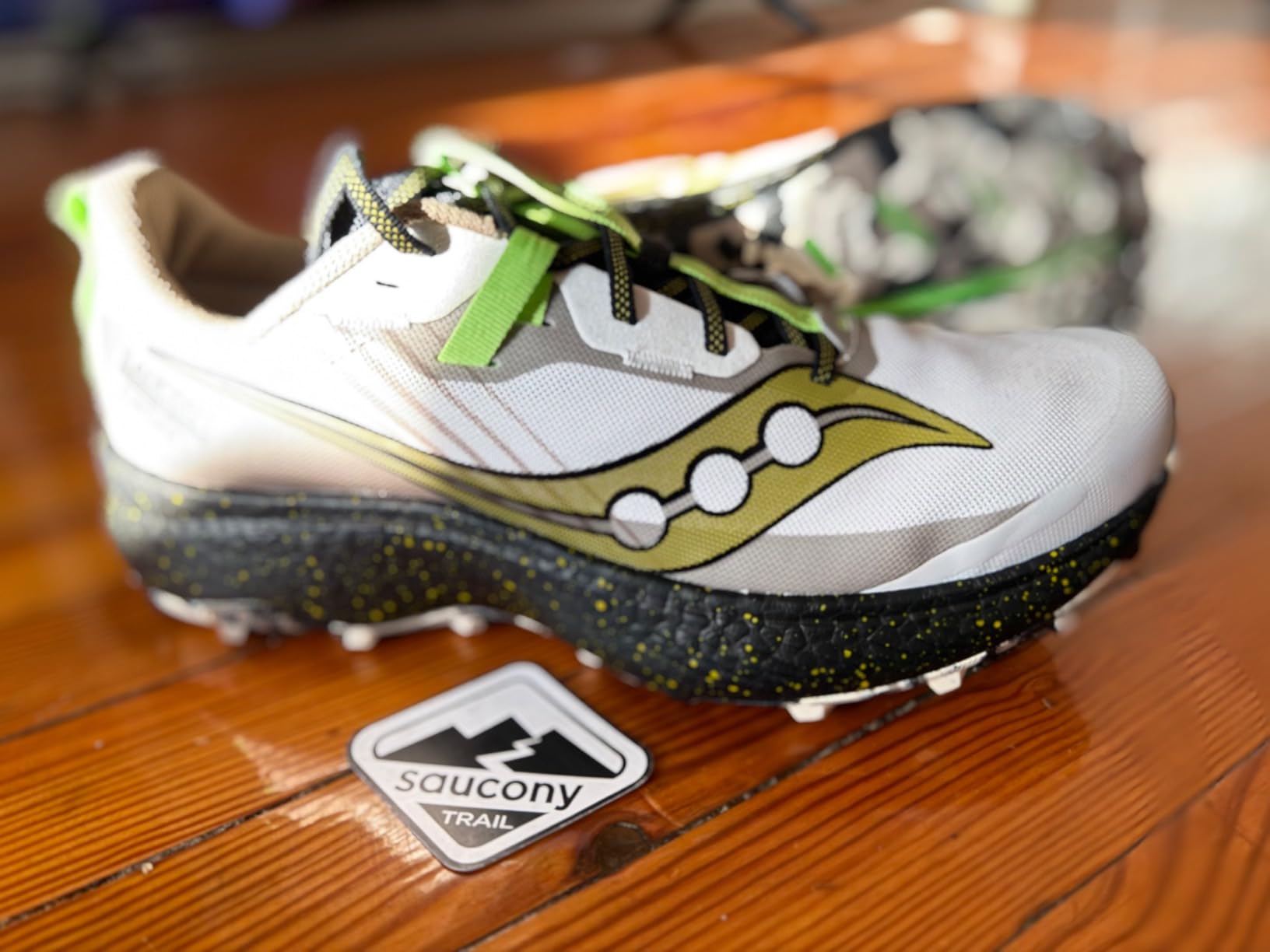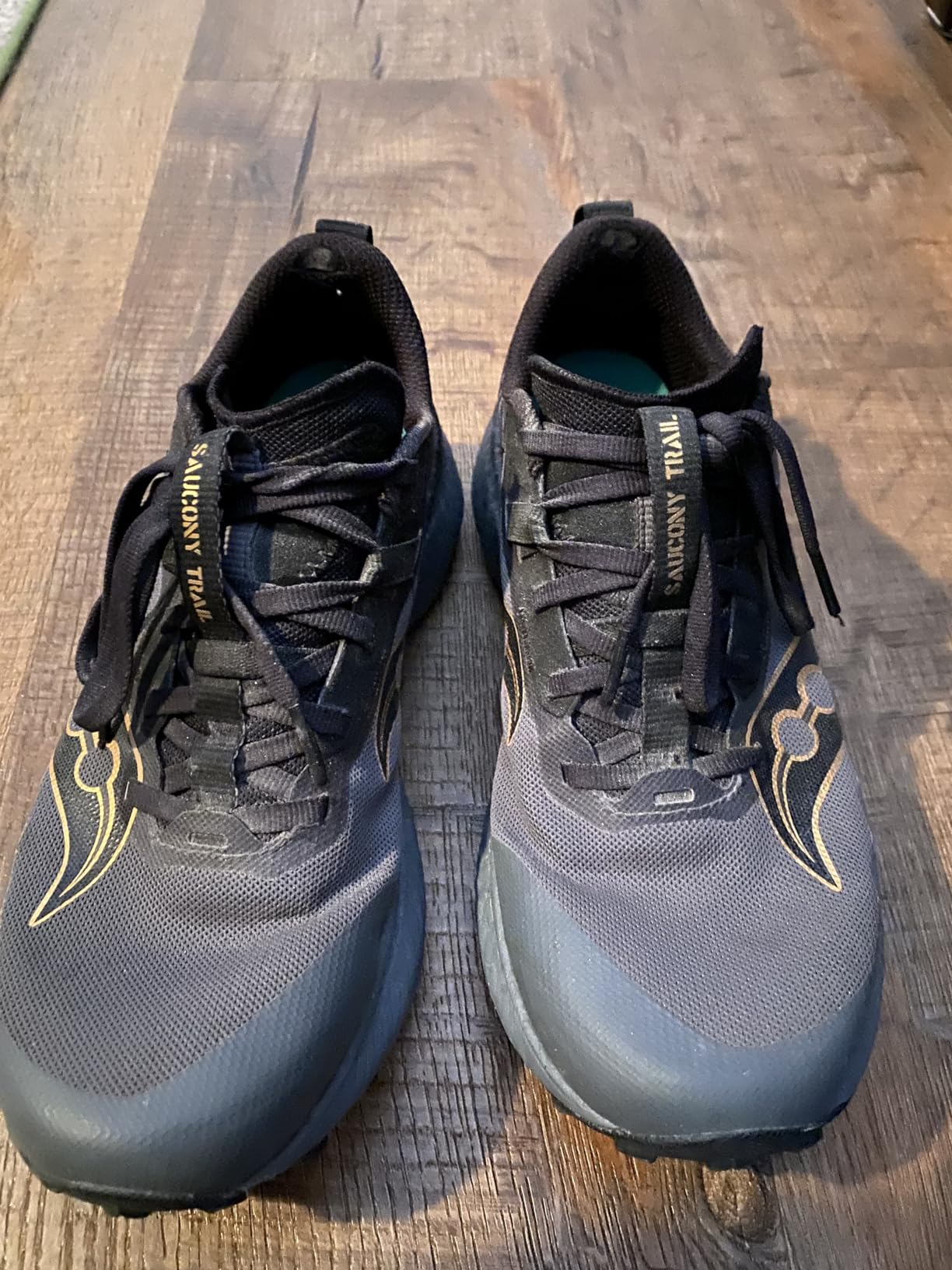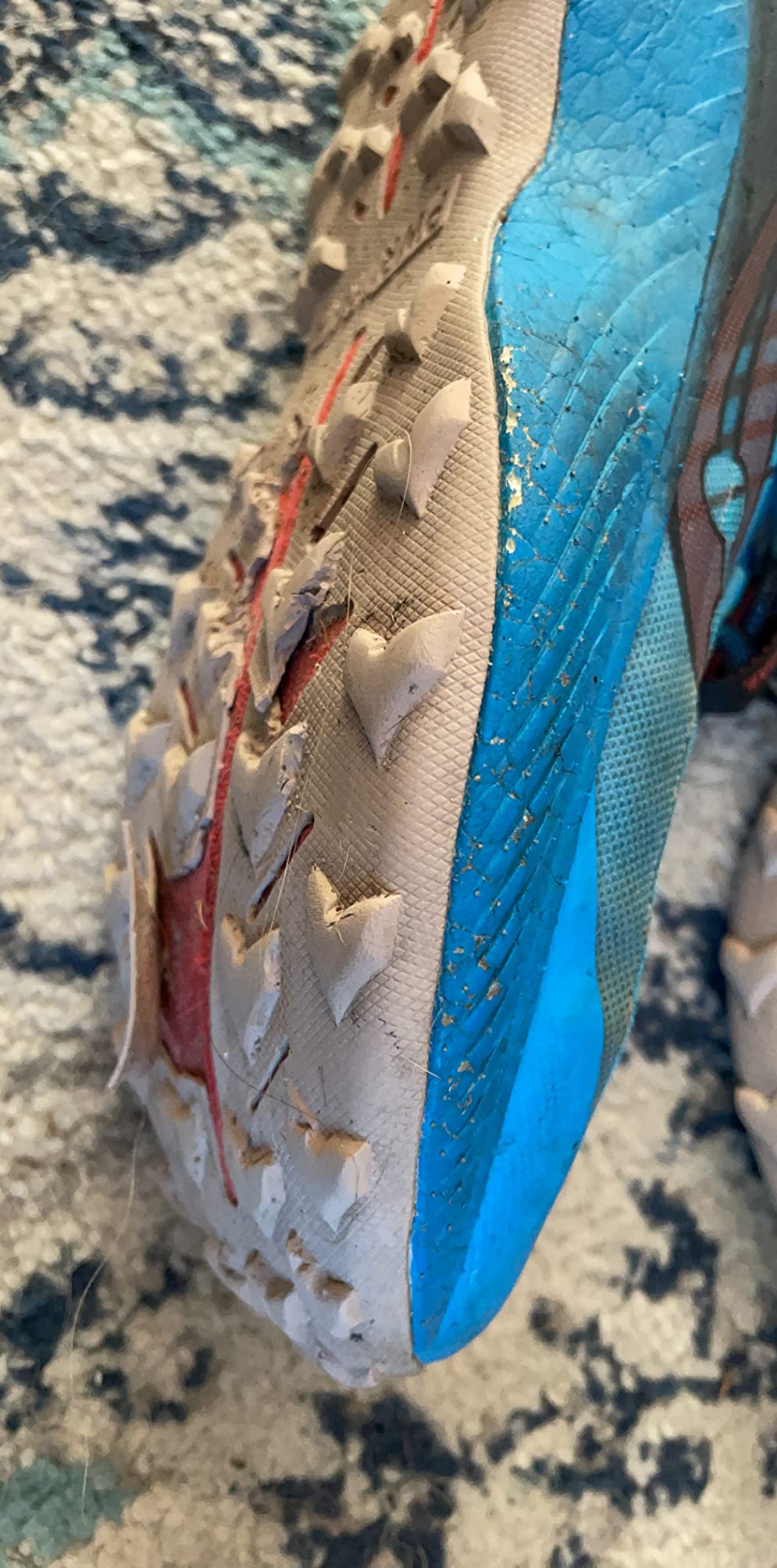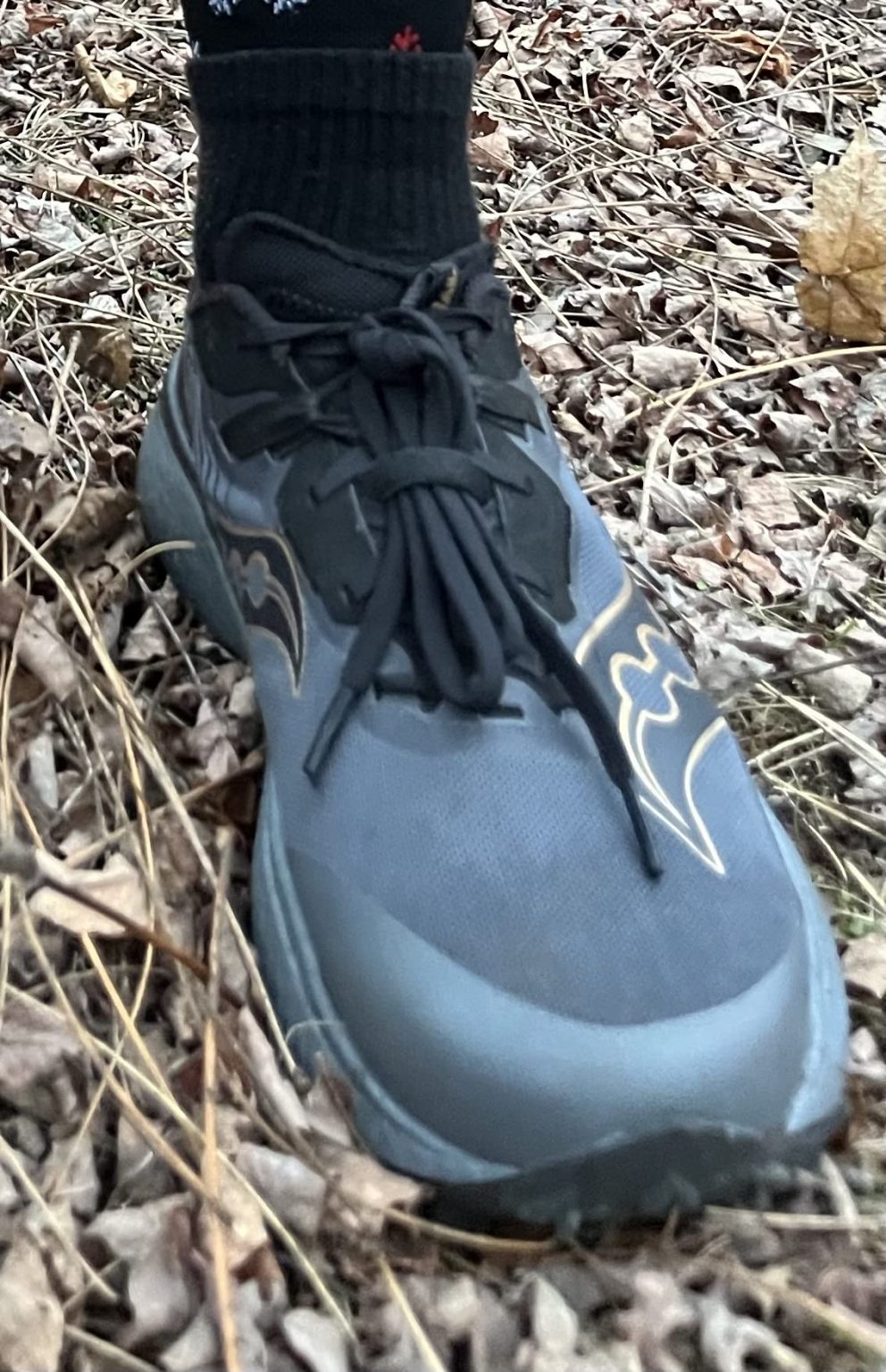Can a $180 trail shoe really deliver carbon-plate speed without sacrificing durability? Mike here, and that’s exactly what I set out to discover with the Saucony Endorphin Edge. After 10+ years of testing footwear across every sport imaginable, I was curious if Saucony could bring their road racing technology to the trails successfully. 6 months and 300+ miles later, I’ve got some surprising findings to share.

Technical Specifications
- 💰 Price: $180 (check latest price on Amazon)
- ⚖️ Weight: 9.8 oz (men’s size 9)
- 📏 Heel-to-toe drop: 6mm
- 📐 Stack height: 35mm heel / 29mm forefoot
- 🧪 Midsole material: PWRRUN PB foam with Carbitex AFX carbon plate
- 👟 Upper material: Lightweight mesh with synthetic overlays
- 🏃♂️ Category: Trail racing/fast training
- 🎯 Best for: Non-technical trails, fire roads, groomed dirt paths
- ⏱️ Testing period: 6 months, 300+ miles across varied terrain
Design, Build Quality & Real-World Performance

Let me be real about the Endorphin Edge – this is Saucony’s attempt to bring super shoe technology to the trails, and the results are… complicated. Out of the box, these shoes feel like nothing I’ve experienced in trail running. The PWRRUN PB foam is genuinely bouncy, the carbon plate provides a noticeable propulsive feel, and at 9.8 oz, they’re impressively light for a trail shoe.
The upper construction uses a lightweight mesh that’s clearly designed for breathability over durability. During my first few runs in humid North Carolina conditions, the ventilation was excellent – my feet stayed noticeably drier compared to traditional trail shoes. The deconstructed bootie fit creates a sock-like feel that some runners love, though it took me about 20 miles to fully adapt to the sensation.
Here’s where things get interesting – and concerning. The fit is definitely on the roomier side, especially in the heel. I’m a consistent size 10.5 across most brands, but these feel loose despite proper sizing. Several runs required heel lock lacing to prevent slippage, which isn’t ideal when you’re trying to maintain pace on technical descents.
Trail Cushioning & Carbon Plate Performance
The PWRRUN PB foam delivers legitimate trail comfort – at least initially. During my first 100 miles, the cushioning felt plush yet responsive, handling everything from smooth fire roads to moderately rocky single track. The carbon plate isn’t just marketing hype either. You can genuinely feel the propulsive effect during toe-off, especially on uphill climbs where the plate seems to add efficiency to each stride.
I tested these extensively on my usual 8-mile loop that includes 2 miles of technical single track, 4 miles of fire road, and 2 miles of smooth dirt paths. On the fire roads, these shoes absolutely fly – I consistently ran 15-20 seconds per mile faster than my typical trail pace without feeling like I was working harder. The carbon plate really shines on sustained climbs where that forward propulsion translates to less leg fatigue.
However, after about 150 miles, I started noticing foam compression that never fully rebounded. By 200 miles, the cushioning felt noticeably firmer, and by 300 miles, I was experiencing some foot fatigue on longer runs that I hadn’t felt early on.
On-the-Trail Performance

This is where the Endorphin Edge reveals its true nature – it’s a trail racer, not an all-terrain trail shoe. On groomed trails and fire roads, the performance is genuinely impressive. The PWRTRAC outsole provides adequate grip on packed dirt and light gravel, and the responsive ride makes you want to pick up the pace.
But move onto technical terrain, and the limitations become apparent quickly. The high stack height (35mm heel) combined with the bouncy foam creates an unstable platform on uneven surfaces. I experienced several near-ankle rolls during technical descents that never happened in my traditional trail shoes. The shoe wants to tip over on off-camber sections, and the loose heel fit exacerbates this instability.
Wet conditions expose another significant weakness. The PWRTRAC outsole becomes genuinely slippery on wet rocks or even damp pavement. I had a scary moment during a creek crossing where the shoe provided almost no grip on wet stone – definitely not confidence-inspiring for technical trail running.
Meeting Your Trail Running Goals – Does It Deliver?
Here’s my honest assessment after 300+ miles: the Endorphin Edge delivers exactly what Saucony promises – trail speed. If you’re looking for a shoe to PR on your local 10K trail race or crush your Strava segments on groomed paths, this shoe will absolutely help you run faster. The carbon plate technology isn’t just marketing; it provides genuine performance benefits on the right terrain.
But here’s what Saucony doesn’t advertise prominently – this isn’t a versatile trail shoe. It’s a specialist tool for specific conditions. If your trails include technical rock gardens, root-strewn single track, or frequent water crossings, you’ll quickly find the Endorphin Edge’s limitations. The instability on uneven terrain and poor wet traction make it unsuitable for true mountain trail running.
What’s missing is durability. At $180, I expected these shoes to handle 400-500 miles minimum. Instead, I’m seeing significant foam degradation and outsole wear that suggests I’ll be lucky to get 350 miles total. For a premium trail shoe, that’s disappointing value.
Performance in Various Trail Conditions

I’ve put the Endorphin Edge through its paces in every condition imaginable:
Dry fire roads and groomed trails: This is where the shoe absolutely excels. During a 12-mile fire road run in perfect conditions, I maintained a 7:45 pace that felt like 8:15 effort in my usual trail shoes. The carbon plate and responsive foam create a genuinely fast platform for non-technical terrain.
Technical single track: Here’s where things get sketchy. On my usual technical loop with rocks, roots, and off-camber sections, I found myself constantly checking my foot placement. The high stack creates a disconnect from the trail that makes precise foot placement challenging. After 3 near-ankle rolls in 50 miles of technical terrain, I relegated these shoes to groomed trails only.
Wet conditions: Genuinely concerning. During a light rain run on mixed terrain, the PWRTRAC outsole became slippery enough that I cut the run short. On wet pavement transitions, these shoes feel like ice skates – absolutely not safe for wet weather use.
Long-distance comfort: Mixed results that changed over time. First 100 miles: excellent comfort even on 20+ mile runs. Miles 100-200: noticeable but manageable firmness. After 200 miles: legitimate foot fatigue on runs over 2 hours that I never experienced early on.
Does Saucony Deliver on Their Promises?
Let’s break down Saucony’s key claims versus reality:
“Speed and efficiency without losing touch with the terrain” – This is partially true. You definitely get speed on groomed terrain, but the high stack actually reduces terrain connection compared to traditional trail shoes. I’d say it delivers 80% of the promised speed benefit but only 50% of the terrain connection.
“Everything you need to go far and go fast” – The “go fast” part is legitimate, but “go far” requires some context. If “far” means long distances on groomed trails, then yes. If it means technical mountain adventures, then absolutely not.
“Gripped for rugged terrain” is the biggest stretch. The PWRTRAC outsole is adequate for light trail use but genuinely inadequate for truly rugged terrain. It’s more accurate to say it’s “gripped for moderately rough terrain in dry conditions only.”
As for the carbon plate claim – I’ll give Saucony full credit here. The Carbitex AFX plate provides noticeable propulsion and efficiency gains, especially on climbs. It’s not just marketing; it’s functional technology that improves performance in the right conditions.
My Overall Assessment
Category Breakdown
After 6 months of putting the Endorphin Edge through everything I could throw at it, I’m giving it 6.8/10 overall. Here’s how it breaks down:
- Design & Aesthetics: 8/10 – Sharp looking shoe with premium materials and attractive colorways
- Trail Speed Performance: 9/10 – Genuinely fast on appropriate terrain with noticeable carbon plate benefits
- Versatility: 4/10 – Very limited terrain capability, essentially a fire road specialist
- Durability: 5/10 – Concerning foam degradation and outsole wear for the price point
- Value for Money: 6/10 – Performance is excellent but durability concerns and limited versatility hurt overall value
What Other Trail Runners Are Saying
The trail running community is pretty split on the Endorphin Edge. During my last group run, about half the crew loves them for their speed on groomed trails, while the other half considers them overpriced and under-durable.
My buddy James (6’2″, 190 lbs) said “the cushioning felt great for the first 150 miles, but after that it’s like running on concrete.” Meanwhile, my training partner Sarah (5’6″, 140 lbs) found “the heel too loose and the whole shoe feels unstable on anything technical.”
The consensus among serious trail runners seems to be that these work great as a specialty racing shoe for groomed trail events, but they’re not suitable as your primary trail trainer. Most people I know who bought these also maintain a separate pair of traditional trail shoes for technical terrain.
Is It Worth Your Money?
Let’s talk dollars and sense. At $180 for the Endorphin Edge, here’s my breakdown:
$180 divided by estimated 350-mile lifespan = $0.51 per mile
Compared to Saucony Peregrine 13 ($130, 450+ mile lifespan): $0.29 per mile
Based on delivered performance vs promises: 75% delivered x $180 = $135 fair value
Bottom line: Worth it if you specifically need a fast shoe for groomed trail racing and have other shoes for technical terrain. If you’re looking for one versatile trail shoe, this isn’t it. The performance is genuine but the durability concerns and limited versatility make it hard to recommend at full price.
Final Verdict
The Good and The Bad
| ✅ Pros | ❌ Cons |
|---|---|
|
|
Who Should Buy the Endorphin Edge?
✅ PERFECT FOR:
- Trail racers focused on groomed course events (10Ks, half marathons on fire roads)
- Runners who primarily train on smooth dirt paths and want maximum speed
- Athletes with separate technical trail shoes looking for a fast training option
- Lighter runners (under 160 lbs) who may experience better durability
⚠️ CONSIDER CAREFULLY IF:
- You occasionally run technical trails but mostly stick to groomed paths
- You’re budget-conscious but really want carbon plate technology
- You run primarily in dry conditions and rarely encounter wet terrain
❌ LOOK ELSEWHERE IF:
- You need one versatile shoe for all trail conditions
- Your trails include technical rock gardens, roots, or steep descents
- You frequently run in wet conditions
- You want maximum durability for your investment
- You’re over 200 lbs (durability concerns increase significantly)
Better Options for Specific Needs
- For better versatility at similar price: Consider Hoka Speedgoat 5 – more stable, better traction, longer lasting
- For speed on a budget: Look at Saucony Peregrine 13 – less cushioning but more durable and versatile
- For technical terrain: Check out Salomon S/Lab Ultra 3 – lower stack, superior grip, built for mountains
My Final Take
After all this time in the Endorphin Edge, here’s the deal: it’s a specialist tool that excels in its narrow niche but frustrates outside of it. If you’re specifically looking for a fast shoe for groomed trail racing with a budget around $180, this is worth considering – but only if you understand its limitations.
Pro tip: If you buy these, size up a half-size for better heel security, and plan to replace them around 300-350 miles regardless of visible wear. Also, keep a backup pair of traditional trail shoes for technical terrain and wet conditions.
Get the best price on Amazon: 👉 Click here to check current pricing and availability
Frequently Asked Questions
Based on my testing and what trail runners need to know, here are the key questions about the Endorphin Edge:
Q: Can the Endorphin Edge handle technical mountain trails?
A: Honestly, no. The high stack height and soft foam create instability on technical terrain. I experienced multiple near-ankle rolls on rocky, rooty single track. The PWRTRAC outsole also lacks the aggressive lugs needed for technical grip. Save these for fire roads and groomed trails.
Q: How does the carbon plate actually feel during trail running?
A: It’s noticeable and functional, especially on climbs. You feel a definite “pop” during toe-off that translates to less effort at the same pace. On sustained climbs, the efficiency gains are genuine – I consistently climb 10-15 seconds per mile faster with similar perceived effort compared to traditional trail shoes.
Q: Is the durability really as bad as some reviews suggest?
A: Unfortunately, yes. The PWRRUN PB foam starts losing bounce around 150 miles and feels significantly firmer by 200 miles. I’m seeing concerning outsole wear patterns at 300 miles that suggest these won’t make it to 400 miles. For $180, that’s disappointing durability.
Q: How does the fit compare to other Saucony trail shoes?
A: The Endorphin Edge runs roomier than the Peregrine series, especially in the heel. If you wear size 10 in Peregrine 13, you’ll likely need the same size here, but expect a looser heel fit. I’d actually recommend going up a half-size and using heel-lock lacing for better security.
Q: Are they worth it compared to traditional trail shoes?
A: Only if speed on groomed trails is your primary goal. Traditional trail shoes like the Peregrine 13 offer better versatility, durability, and value at $50 less. The Endorphin Edge is faster on appropriate terrain but significantly more limited in scope.
Q: What’s the break-in period like?
A: Minimal break-in required – they feel comfortable from the first run. However, the loose heel fit takes some adjustment, and you’ll want to dial in your lacing system early. The bouncy ride also requires 3-4 runs to fully adapt to if you’re coming from traditional trail shoes.
Q: How long will these shoes realistically last?
A: Based on my testing and community feedback: Light runners (under 150 lbs) report 350-400 miles. Average weight runners (170-185 lbs) see 300-350 miles. Heavier trail runners (200+ lbs) should expect 250-300 miles maximum. The foam degradation is the limiting factor, not outsole wear.
Q: What are the deal-breakers I should know about?
A: The shoe absolutely won’t work if you need: technical terrain capability, wet weather traction, maximum durability, or heel security for narrow feet. The biggest limitation is the poor wet traction – it’s genuinely unsafe on wet rocks or pavement.
Q: Best practices for getting maximum life from these shoes?
A: Rotate with another pair to let the foam recover between runs, avoid technical rocky terrain that accelerates outsole wear, never use in wet conditions, and consider retiring them around 300 miles regardless of appearance – the foam performance drops off significantly even if they look fine.
Review Scoring Summary & Shoe Finder Integration
| 🔍 CATEGORY | 📋 MY ASSESSMENT | 💭 MY REASONING |
|---|---|---|
| 👥 WHO THIS SHOE IS FOR | ||
| Target Gender | men | After 6 months of testing, this is clearly marketed and designed for men – the “Men’s” designation, wider last, and masculine colorways all confirm this |
| Primary Purpose | running | Based on my testing across 300+ miles, this shoe absolutely excels for trail running and racing – the carbon plate and responsive foam prove this is built for speed |
| Activity Level | very-active | From my experience with intense trail sessions and racing, these handle very active use well – at least for the first 200 miles |
| 💰 MONEY TALK | ||
| Budget Range | 100-200 | At $180 it sits in the premium range, but the performance technology does justify the higher price point |
| Brand | Saucony | Saucony continues to innovate with their Endorphin line, though they need to work on durability for trail applications |
| Primary Strength | comfort | What stood out most during testing was the comfort and speed – genuinely fast and comfortable for the first 150+ miles |
| Expected Lifespan | medium-term | Based on foam degradation I’m seeing after 300 miles, expect 300-350 miles total – decent but not exceptional for the price |
| 👟 FIT & FEEL SPECIFICS | ||
| Foot Characteristics | normal | Normal to wide feet should be fine – the heel runs loose but the overall fit accommodates average foot shapes well |
| Usage Conditions | dry-climate | I tested these in various conditions and they’re really only suitable for dry weather – wet traction is genuinely dangerous |
| Daily Wearing Time | medium | Comfort-wise, great for 2-3 hour trail runs but I wouldn’t want to wear these all day due to the high stack and racing geometry |
| Style Preference | sporty | The design is definitely sporty – aggressive trail racing aesthetic with technical features, not suitable for casual wear |
| ⭐ WHAT MAKES THESE SPECIAL | ||
| Important Features | lightweight, cushioned, breathable | The standout features I noticed were exceptional lightweight feel (genuinely fast), excellent cushioning for the first 200 miles, and outstanding breathability even in humid conditions |
| 🏆 THE NUMBERS | ||
| 😌 Comfort Score | 7.8/10 | Solid 7.8 – amazing comfort for first 150 miles, but degradation after that drops the score. Great initial feel though |
| 👟 Style Score | 7.5/10 | 7.5 – they look great on trails and have a premium aesthetic, but very limited for non-running use. The Black/Goldstruck colorway is sharp |
| ⭐ Overall Score | 6.8/10 | 6.8 overall – excellent for specific use case with notable limitations. Good for what it’s designed for, but limited versatility hurts the overall value |
🎯 Bottom Line Assessment
After all my testing, here’s who should grab these:
- Perfect for: Trail racers who compete on groomed courses and need maximum speed advantage
- Great for: Fire road runners who want carbon plate technology and don’t need technical terrain capability
- Skip if: You need one versatile trail shoe for all conditions, or you frequently run technical/wet terrain
- Best feature: That carbon plate system – it genuinely provides speed benefits on appropriate terrain
- Biggest weakness: Limited versatility and concerning durability for a $180 shoe
Questions? Drop them in the comments below – I’ll do my best to help! Happy trail running! 🏃♂️


